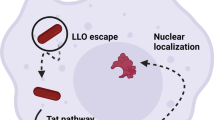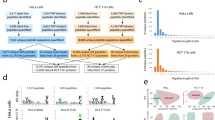Abstract
Bacteria-mediated transfer of plasmid DNA into mammalian cells (bactofection) is a potent approach to express plasmid-encoded heterologous proteins (protein antigens, toxins or enzymes) in a large set of different cell types including phagocytic and nonphagocytic mammalian cells. Previously, we have described a Listeria monocytogenes-mediated DNA delivery system, which releases plasmid DNA directly into the cytosol of mammalian cells by partial self-destruction of the carrier bacteria. Here we report on a second generation of this phage lysin supported bactofection system, which is greatly improved with respect to plasmid stability, transfer efficacy and biosafety. In this case, DNA release is initiated by spontaneous bacterial lysis in the infected cells cytosol which is subsequently enhanced by the simultaneously released phage lysin produced by the intracellular carrier bacteria. Bacteria that are capable of cell-to-cell spread are found to be much more efficient in bactofection than their nonspreading counterparts.
This is a preview of subscription content, access via your institution
Access options
Subscribe to this journal
Receive 12 print issues and online access
$259.00 per year
only $21.58 per issue
Buy this article
- Purchase on Springer Link
- Instant access to full article PDF
Prices may be subject to local taxes which are calculated during checkout










Similar content being viewed by others

References
Ulmer JB et al. Heterologous protection against influenza by injection of DNA encoding a viral protein. Science 1993; 259: 1745–1749.
Tang DC, Devit M, Johnston SA . Genetic immunization is a simple method for eliciting an immune response. Nature 1992; 356: 152–154.
Donnelly JJ, Ulmer JB, Shiver JW, Liu MA . DNA vaccines. Annu Rev Immunol 1997; 15: 617–648.
Gurunathan S, Klinman DM, Seder RA . DNA vaccines: immunology, application, and optimization. Annu Rev Immunol 2000; 18: 927–974.
Shata MT et al. Recent advances with recombinant bacterial vaccine vectors. Mol Med Today 2000; 6: 66–71.
Sizemore DR, Branstrom AA, SadoffJC . Attenuated Shigella as a DNA delivery vehicle for DNA-mediated immunization. Science 1995; 270: 299–302.
Courvalin C, Goussard S, Grillot-Courvalin C . Gene transfer from bacteria to mammalian cells. C R Acad Sci 1995; 318: 1207–1212.
Sizemore DL, Branstrom AA, Sadoff JC . Attenuated bacteria as a DNA delivery vehicle for DNA-mediated immunization. Vaccine 1997; 15: 804–807.
Grillot-Courvalin C, Goussard S, Courvalin P . Wild-type intracellular bacteria deliver DNA into mammalian cells. Cell Microbiol 2002; 4: 177–186.
Darji A et al. Oral somatic transgene vaccination using attenuated S. typhimurium. Cell 1997; 91: 765–775.
Grillot-Courvalin C et al. Functional gene transfer from intracellular bacteria to mammalian cells. Nat Biotechnol 1998; 16: 862–866.
Al-Mariri A et al. Yersinia enterocolitica as a vehicle for a naked DNA vaccine encoding Brucella abortus bacterioferritin of P39 antigen. Infect Immun 2002; 70: 1915–1923.
Dietrich G et al. Delivery of antigen-encoding plasmid DNA into the cytosol of macrophages by attenuated suicide Listeria monocytogenes. Nat Biotechnol 1998; 16: 181–185.
Hense M et al. Eukaryotic expression plasmid transfer from the intracellular bacterium Listeria monocytogenes to host cells. Cell Microbiol 2001; 3: 599–609.
Powell RJ, Lewis GK, Hone DM . Method for introducing and expressing genes in animal cells and live invasive bacterial vectors for use in the same. US Patent No. 5877159. 1999.
Weiss S, Chakraborty T . Transfer of eukaryotic expression plasmids to mammalian host cells by bacterial carriers. Curr Opin Biotechnol 2001; 12: 467–472.
Krusch S et al. Listeria monocytogenes mediated CFTR transgene transfer to mammalian cells. J Gene Med 2002; 4: 655–667.
Yuhua L et al. Oral cytokine gene therapy against murine tumor using attenuated Salmonella typhimurium. Int J Cancer 2001; 94: 438–443.
Loessner MJ, Wendlinger G, Scherer S . Heterogeneous endolysins in Listeria monocytogenes bacteriophages: a new class of enzymes and evidence for conserved holin genes within the siphoviral lysis cassettes. Mol Microbiol 1995; 16: 1231–1241.
Flamm RK, Hinrichs DJ, Thomashow MF . Introduction of pAM beta 1 into Listeria monocytogenes by conjugation and homology between native L. monocytogenes plasmids. Infect Immun 1984; 44: 157–161.
Glaser P et al. Comparative genomics of Listeria species. Science 2001; 294: 849–852.
Gambotto A et al. Immunogenicity of enhanced green fluorescent protein (EGFP) in BALB/c mice: identification of an H2-Kd-restricted CTL epitope. Gene Therapy 2000; 7: 2036–2040.
Goetz M et al. Microinjection and growth of bacteria in the cytosol of mammalian host cells. Proc Natl Acad Sci USA 2001; 9: 12221–12226.
Wuenscher MD, Köhler S, Goebel W, Chakraborty T . Gene disruption by plasmid integration in Listeria monocytogenes: insertional inactivation of the listeriolysin determinant lisA. Mol Gen Genet 1991; 228: 177–182.
Kolb-Mäurer A et al. Listeria monocytogenes-infected human dendritic cells: uptake and host cell response. Infect Immun 2000; 68: 3680–3688.
Kuhn M, Prévost MC, Mounier J, Sansonetti PJ . A nonvirulent mutant of Listeria monocytogenes does not move intracellularly but still induces polymerization of actin. Infect Immun 1990; 58: 3477–3486.
Pfeuffer T et al. LaXp180, a mammalian ActA-binding protein, identified with the two-hybrid system, co-localizes with intracellular Listeria monocytogenes. Cell Microbiol 2000; 2: 101–114.
Geginat G et al. Suppression of acquired immunity against Listeria monocytogenes by amphotericin B-mediated inhibition of CD8 T cell function. J Infect Dis 1999; 180: 1186–1194.
Azuma M et al. Functional expression of B7/BB1 on activated T lymphocytes. J Exp Med 1993; 177: 845–850.
Geginat G et al. Enhancement of the Listeria monocytogenes p60-specific CD4 and CD8 T cell memory by nonpathogenic Listeria innocua. J Immunol 1999; 162: 4781–4789.
Dietrich et al. Life attenuated bacteria as vectors to deliver plasmid DNA vaccines. Curr Opin Mol Ther 2003; 5: 10–19.
Acknowledgements
We thank M Kuhn and B Joseph for the critical reading of the manuscript and Ch Berberich for the kind gift of KMP-11 cDNA. This work was supported by a grant from the Deutsche Forschungsgemeinschaft (Go168/27-1) and the Fonds der Chemischen Industrie. SP thanks the DFG Graduate College (GK520), and CS The BMBF (IZKF Würzburg, 01KS9603) for financial support.
Author information
Authors and Affiliations
Rights and permissions
About this article
Cite this article
Pilgrim, S., Stritzker, J., Schoen, C. et al. Bactofection of mammalian cells by Listeria monocytogenes: improvement and mechanism of DNA delivery. Gene Ther 10, 2036–2045 (2003). https://doi.org/10.1038/sj.gt.3302105
Received:
Accepted:
Published:
Issue Date:
DOI: https://doi.org/10.1038/sj.gt.3302105
Keywords
This article is cited by
-
Bacterial therapies at the interface of synthetic biology and nanomedicine
Nature Reviews Bioengineering (2023)
-
Increasing the bactofection capacity of a mammalian expression vector by removal of the f1 ori
Cancer Gene Therapy (2019)
-
Interaction between Pasteurella multocida B:2 and its derivatives with bovine aortic endothelial cell (BAEC)
BMC Veterinary Research (2017)
-
Assessment of navigation control strategy for magnetotactic bacteria in microchannel: toward targeting solid tumors
Biomedical Microdevices (2013)
-
Delivery of functional DNA and messenger RNA to mammalian phagocytic cells by recombinant yeast
Gene Therapy (2012)


